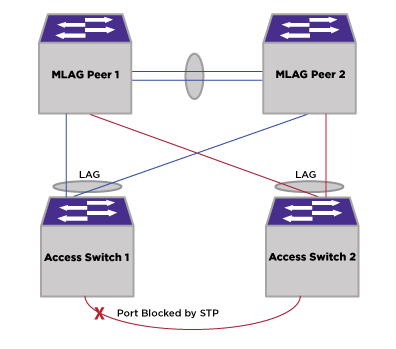STP and MLAG
You can configure MSTP and RSTP on MLAG peers and access switches, which can prevent loops in networks containing MLAG topology. This allows third-party switches to be connected to MLAG topology (as access switches) and an MSTP or RSTP domain can span ExtremeXOS and third-party switches.
In typical MLAG deployments (see MLAG and MSTP/RSTP), connections can exist between access switches, which can cause data loops. By configuring MSTP/RSTP on all the nodes, loops can be effectively prevented.
You should configure the MSTP/RSTP domain in the MLAG peers with a higher priority than the access switches, which blocks the redundant link between access switches. The LAG links in blue form one set of MLAG links and the corresponding ports at MLAG peers are associated with one MLAG index. The LAG links in red form another set of MLAG links, and the corresponding ports at MLAG peers are associated with another MLAG index.

MSTP/RSTP is supported in simple and two-tier MLAG topologies.
For the purpose of synchronization of protocol information, a master is elected for each MLAG index between MLAG peers, based on switch MAC address of peers and MLAG index. By choosing MLAG index with odd or even number, it is possible to change mastership between MLAG peers. Only the master node will transmit BPDUs and process BPDUs. Port roles and states are computed by the master node for the given MLAG index and applied on the local MLAG port. These details are check pointed to the backup node and are applied on its MLAG port.
Recommendations for Configuring MSTP/RSTP with MLAG
You should configure in such a way that one of the MLAG peers become root bridge (see Bridge Priority), and also configure MLAG peers with backup root option (see Backup Root). The former avoids less powerful access switches from becoming the root bridge; the latter facilitates faster convergence as the other MLAG peer becomes root bridge quicker. Loop protect feature (see Loop Protect) should not be enabled on LAG ports (which are part of the MLAG topology) on access switches. This is because a multi-source condition is triggered when one of the two MLAG peers goes down. The loop protect feature prevents the port from going to the forwarding state, if configured. However, enabling this feature on MLAG ports is acceptable.
Since both MLAG peers should act like single switch, the ISC link should not be blocked, regardless of MSTP/RSTP role. Keeping this in mind, the port cost of the ISC port is chosen internally to be the lowest possible value (see Default Port Path Cost). This helps in selecting the ISC link as the active link if there are any parallel links to the ISC. MLAG links do not have special preference over redundant connections that are in parallel to the MLAG link. The standard MST/RSTP algorithm disables both MLAG links if it has higher root path cost than the redundant link. This allows the lower cost link to be chosen as active link. If you configure MSTP over MLAG, both MLAG peers and access switches should be in the same MSTP region. This makes MLAG and ISC ports internal ports.

